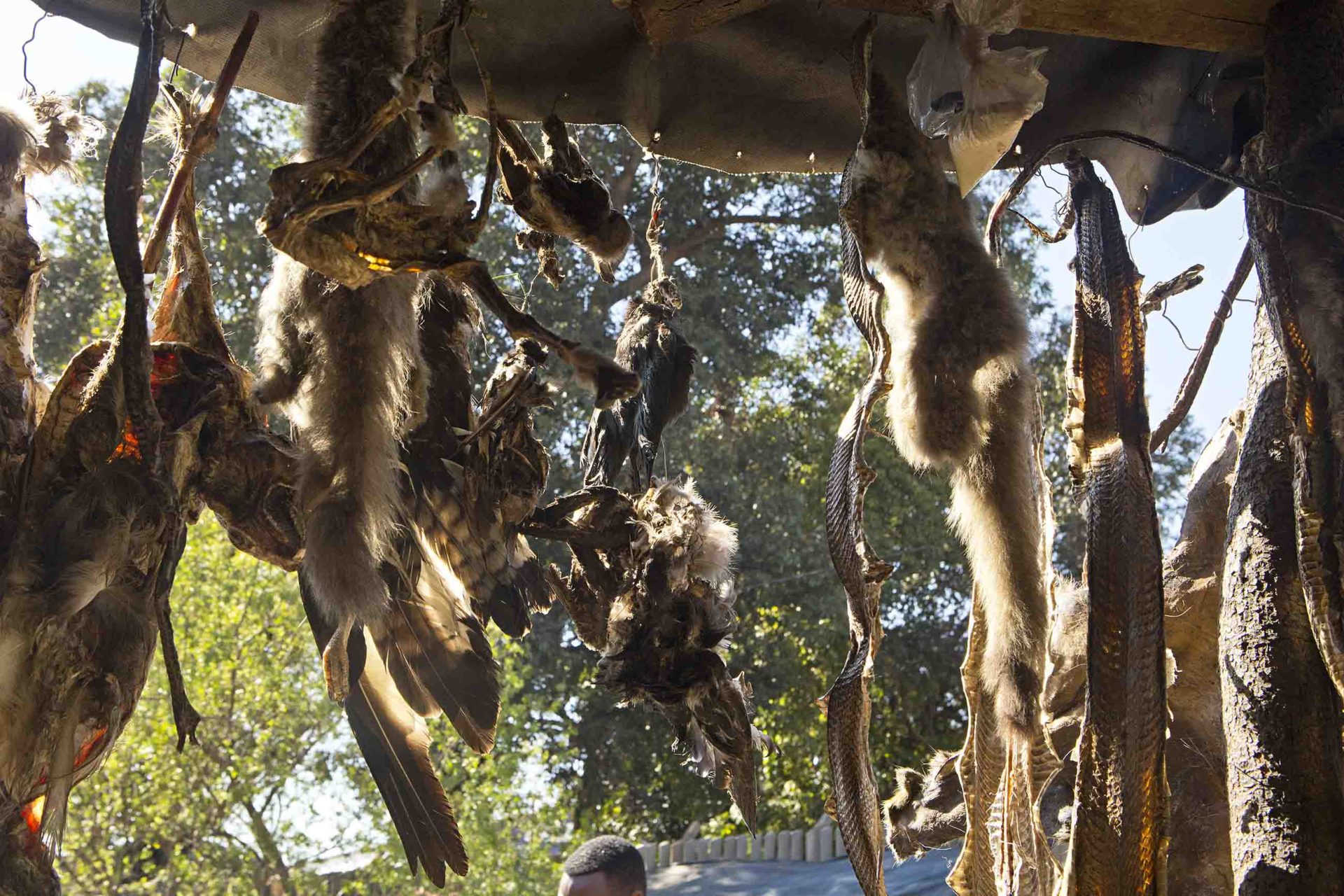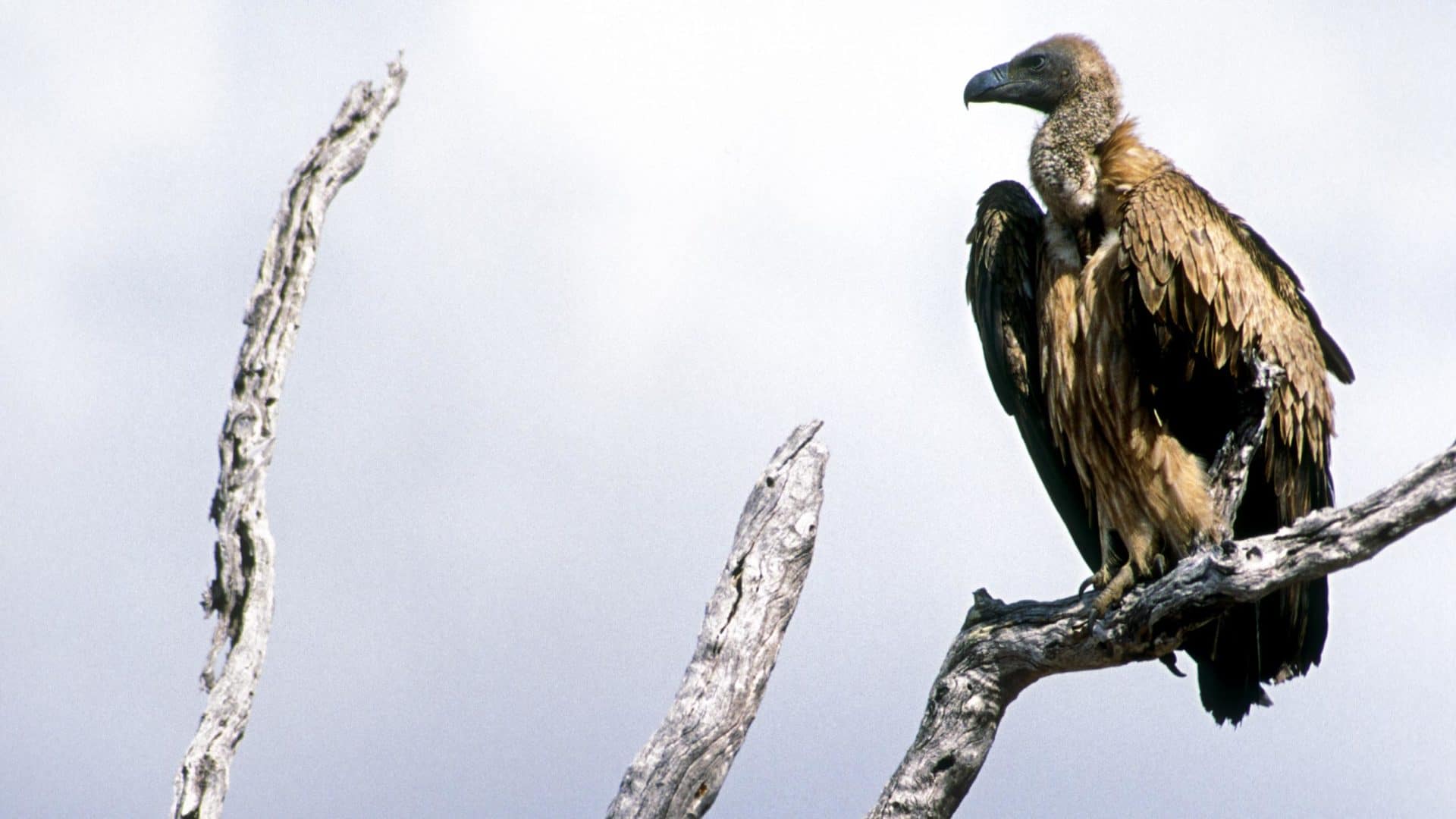Traditional Medicine Threatens South Africa’s Vultures
On a clear, crisp winter night on Somkhanda Game Reserve in KwaZulu-Natal, South Africa, a truck hurtles down a dirt road. In the back, heaps of trash bags stuffed with white-backed vulture corpses emit the stink of vomit and rotting meat. Two surviving vultures crouch on the laps of rangers, occasionally making pitiful mewlings.
All the vultures they picked up were poisoned, with the two survivors rushed to veterinary care. According to the reserve’s manager, Meiring Prinsloo, local villagers who collectively own the reserve said the vultures were targeted for use in traditional medicine.
It’s not just vultures. The wildlife trade for traditional medicine — called “belief use” — “has a bigger impact than the ivory trade, and the rhino trade, and the lion trade,” says Vivienne Williams, an ethnobotanist and ethnozoologist at the University of the Witwatersrand in Johannesburg. Williams has found more than 600 plant species traded for traditional medicine, with tons of material harvested annually, 82 species threatened with local extinction, and another hundred “of conservation concern.”
The threat that belief use poses to endangered African wildlife is more commonly associated with the use of rhino horn in Vietnamese and Chinese traditional medicine. But African traditional medicine, called muthi in many parts of Southern Africa, poses a substantial conservation threat of its own.
There’s a vast range of animals in the trade, too: Williams and her colleagues have found sales of more than 147 species of vertebrates, including 17 threatened species, for sale in a major medicine market in Johannesburg.
“There are more individual animals in this muthi trade than there are elephants killed,” says Williams. The ivory trade is more intense, with a limited number of people involved and higher value, she adds, “but this pan-African trade in traditional medicine is far more widespread, and I think people underestimate the impact that it’s probably having.”
As for vultures like those poisoned at Somkhanda Game Reserve, belief use is one of the most serious threats to endangered and critically endangered species. The continent’s vulture populations are collapsing rapidly, and belief use accounts for nearly 30 percent of the vulture deaths recorded in 26 countries between 1961 and 2014.
This local impact is often overlooked, “because [of] this other thinking that maybe China is the problem or Vietnam is the problem,” says Nolwazi Mbongwa, an ethnobotanist and traditional healer — or sangoma. She says analyzing the global issue is premature “when we haven’t even understood that our own dynamic in South Africa is an issue.”
Traditional medicine, which encompasses both herbalism and spiritual practices such as divination, plays an important role in the lives of many South Africans. But the wide range of cultures within South Africa means that different animal and plant substances can be used in different ways.
“African culture is not a homogeneous lump,” says Nokulinda Mkhize, a South African sangoma. Which treatments are used, and how they are used, depends on the region, the culture, and the individual healer. Universal ethics and guidelines underlie traditional medicine, says Mkhize, but “there is a lot of room for negotiation and a lot of room for flexibility in terms of how we articulate our practices.” And some sangomas prefer not to use animal products at all, says Mbongwa.

Still, there are commonalities. In both West Africa and Southern Africa, for instance, vultures are considered valuable because of their excellent eyesight, thought to bring foresight and good luck. According to Mbongwa, vulture brains and heads may be incinerated and inhaled, or included in a mixture that is kept under a client’s pillow. This follows the “Doctrine of Signatures,” the principle by which the qualities of an animal or plant dictate what they can be used for. “If it’s red, it’s used for blood; if it looks like a brain, it’s used for your brain,” says Williams, and “if it’s a big strong animal, it’s used for strength.”
Some people in South Africa make use of both biomedicine and traditional medicine complementarily, just as North Americans might choose to visit a doctor, a nutritionist, a priest, and a psychiatrist. Thabile Nawe, a history graduate student at the University of KwaZulu-Natal whose research focuses on the clients of traditional healers, says that personal preference, financial concerns, and convenience may all play a role.
Apartheid-era legislation forced people of color into dislocated “townships” located outside of major cities, and so healers located within these communities may be easier to reach than hospitals, Nawe says. Government clinics provide free or reduced-price health care but are often overcrowded and underfunded, while private health care is expensive.
“I use both,” says Nawe — biomedicine for physical ailments, and traditional medicine for spiritual and psychological guidance. Explaining why she continues to use traditional medicine, she says, “I really do feel that it’s something that’s part of who we are.”
Back on the truck at Somkhanda, the game reserve staff ease the two surviving vultures into crates, ready to face the five-hour drive to a rescue sanctuary. The rangers keep their hands and faces covered to avoid any contact with traces of the poison — assumed to be carbamate, a class of agricultural pesticides that are toxic not just to vultures, but to people.
The dead vultures likely have significant chemical residues on their mouths and heads from eating the poisoned meat and it’s thought that “the heads are what’s most frequently used by people,” says Andre Botha, a program manager at the Endangered Wildlife Trust. The extent of the risk to healers and their clients is currently unknown, he adds. Safe sourcing is a concern within the healing community, says Mbongwa. “We are also as vulnerable,” she says, “as our patients are.”
Many traditional healers try to work only with materials they personally source. “We are guided by very strict ethics in terms of who can hunt, when things can be hunted, how they must be hunted, and what offerings must be given,” says Mkhize.
But personal sourcing has grown increasingly difficult, particularly over the 20th century. Migrant labor has drawn people to cities and apartheid-era laws forcibly removed black communities from their land, divorcing the healers from their traditional ethics and forcing them to rely on a murky supply chain. The commodification of traditional medicine and the resulting competition, says Karen Flint, a historian at the University of North Carolina at Charlotte, began to drive over-harvesting.
This history is inextricably bound to the current problem — and any potential solutions. Conservation often operates from the racist premise that “black people don’t care about nature,” says Mkhize. But the damage wrought by traditional medicine, she says, is a drop in the ocean compared to the global environmental damage caused by agriculture and industrialization. “Our entire practice is premised on protecting nature, because we need nature,” says Mkhize. “We cannot be izangoma” — the isiZulu language plural of sangoma — “if we have nothing left.”
Considering goals of conservationists and healers, “these two worlds are able to work hand in hand,” says Mbongwa. But top-down solutions developed by conservationists and researchers have not helped, she argues. She hopes a more grassroots approach that focuses on the conservation ethics present in traditional belief systems, invites people’s expertise, and encourages frontrunners to adopt new practices could be more successful.
“You build the bridge until everybody can walk on it,” she says.
Poverty obstructs conservation efforts, she adds. There’s not only a financial incentive to hunt and sell vulture parts, but the use of vulture heads is also linked to poverty. “It’s a huge motivator in the use of vultures,” Mbongwa says — because people think it means good luck, easy money, and a higher chance of getting out of poverty.
Today, the two survivors of Somkhanda’s poisoning incident are recovering, ready to be released in November. But the 17 vultures that didn’t make it are just a fraction of the 764 white-backed vultures killed in South Africa, Botswana, and Namibia this year.
Distributed across much of west, east, and southern Africa, white-backed vultures face a range of threats including habitat loss, electrocution on poorly-designed power lines, and poisoning — due to belief use, for food, as collateral damage when the vultures feed on other poisoned animals, and more — and are expected to suffer population declines of approximately 90 percent over three generations. In West Africa, where vultures are commonly hunted for food and belief use, declines of white-backed vultures have been higher than 90 percent, and the species has largely disappeared from Nigeria, northern Cameroon, and most of Ghana and Niger.
Motive can be difficult to determine, says Botha. If a vulture feeds on a poisoned elephant carcass, for instance, it suggests that poachers intended to keep the vultures out of the sky so they wouldn’t draw attention to the illegal kill. If the carcass is bait, like an impala, it could be intended for a livestock predator, or for vultures. Or there may be multiple motives in a single poisoning.
While it may be difficult to determine motive, belief use — established based on dead vultures found without heads, or for sale at traditional medicine markets — still accounted for 29 percent of the recorded vulture deaths across 26 African countries between 1961 and 2014, according to a 2015 paper in Conservation Letters. The African Wildlife Poison Database has a lower estimate, attributing approximately 12 percent of deaths across 17 countries between 1973 and 2015 — although the reasons for a further 27 percent of deaths are categorized as “unknown” in the database.
In South Africa, declines of white-backed vultures and white-headed vultures are rapid enough that a 2013 paper in Vulture News projected local extinction as early as 2024 — or 2040 in a best-case scenario — based on the extent of vulture parts found in a survey of traditional medicine markets. Because of their rapid decline and slow breeding rates, white-backed vultures are listed as critically endangered by the IUCN — the same threat level as the black rhino, and a considerably higher threat level than the white rhino. Of eight vulture species common across Africa, four are critically endangered, three endangered, and one is considered near threatened.
Africa’s vulture crisis threatens devastating effects in fragile ecosystems, as well as risks to human health. Vultures’ highly adapted digestive systems are the end of the line for diseases such as anthrax and tuberculosis; without them, there is a higher risk of disease transmission from carcasses.
The loss of these and other species that are important to traditional medicine would mean “losing part of my culture, part of my identity,” says Mbongwa. “It would be a loss of self.”
Cathleen O’Grady is a South African science writer based in Scotland. Her work on the use and abuse of science in societal decision-making has appeared in Hakai, The Guardian, FiveThirtyEight and Ars Technica.
UPDATE: Due to an editing error, a previous version of this story failed to provide the full name, on first reference, for Andre Botha, a program manager at the Endangered Wildlife Trust.










